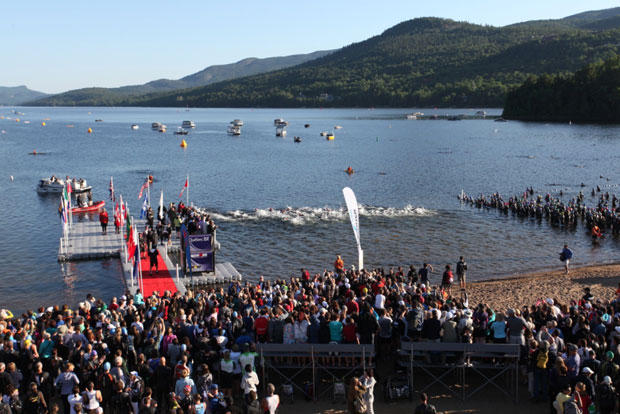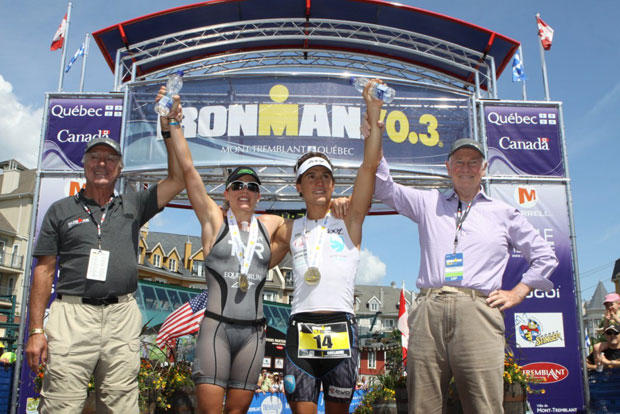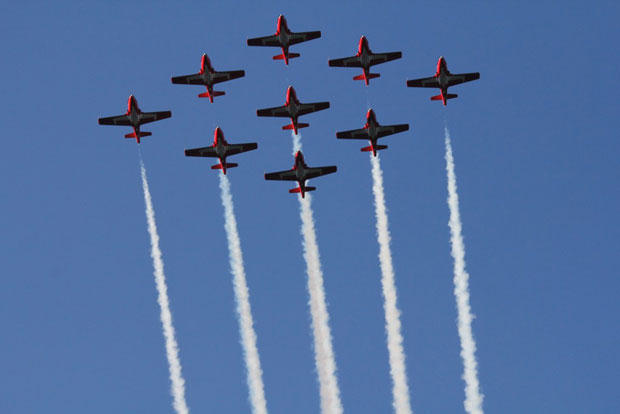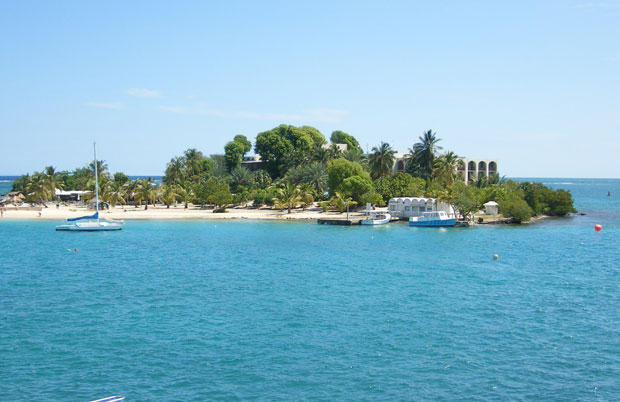A 70.3 Mt Tremblant primer
With the Ironman 70.3 World Championships moving over from Las Vegas to Mont Tremblant for 2014, there are probably a lot more athletes from around the world interested in getting visibility into this venue than previously.
In 1998 when Graham Fraser first looked at new venues to expand the full Ironman distance into North America, Mont Tremblant came up as an almost perfect venue. It has plenty of hotels at the base of the ski hill, a great lake, good roads for running a full Ironman distance event, and quick access to major urban areas and airports. Montreal, the host of the 1976 Olympics is barely 90 minutes away and the nation’s capital Ottawa is around 100 min of driving from Mont Tremblant. Unfortunately for Mont Tremblant, even though it had everything needed to make it a perfect venue, it had to wait 14 years from those days when it was first scouted.
Bringing the Ironman North America championship was a natural extension to marketing the resort to North Americans, but this resort has a much larger reach in terms of attracting Europeans for winter sport. Bringing the 70.3 World’s to Tremblant is just an extension to this mindset that the entire town has. If they do something, they plan to do it on the world stage. Judging by the quality of the first year events at Tremblant this should be a good fit for all parties.

Our survival guide of the St. Croix Ironman was a fairly popular feature among the athletes who raced there. We’ll try to share some of the same details on Tremblant, sticking to the 70.3 for now. We get a lot of questions in our reader forum about various courses, what gearing is needed, climbs, technical descents, weather peculiarities, congestion and so on. In the next part of this article we’ll try to answer most of what we have read and already answered in the reader forum, but try to put it in one place.
Bike Course
What do you need to know about the bike course? Since this article is on Slowtwitch, the bulk of the questions we get are about the bike. After all, a triathlon is a bike race sandwiched between a swim warm up and a run cool down (if anyone thinks we are serious, you probably have not hung around our reader forum enough). Serious or not, the bike course really is the distinguishing feature of this course with around 3000 feet of climbing for 56 miles. But as we wrote about at St. Croix, it’s about the person who can get to the finish line the fastest. With the amount of climbing on this course, it can be easy to blow things too early, fall apart in the climbing during the late stages of the bike and then shuffle/walk home. Don’t be that person at Mont. Tremblant.
We can essentially divide the course into 4 phases. The first part consists of rollers and false flats heading out of the resort on Montee Ryan for around 9-10K with short climbs that you can carry your speed part way up. Depending on how strong you are, they may be big chainring for some, but for the majority of participants, the small chain ring will kick in too. Then you have almost 25K of gradual climbs or false flats along the highway heading to the first major turn around. As you get on the highway there is a fairly long climb that is 5-6% grade. As it comes early in the race, lots of people tend to hammer this one. Once you are done, the bulk of the early climbing is over. But it catches up quickly and it can be windy on this section. You will be riding out on a highway that is closed for the race, so it is not too sheltered from wind. During the 70.3 most will escape heavy winds, here, but the day of the Ironman it can be very windy on loop 2. The best way to visualize this section is the wide open area on the Queen K in Kona, except here in Tremblant you are surrounded by dense maple forest of the Laurentian mountain range. For those who raced last year, you will stay on the highway 3k longer than in the previous year as the shoulder has been paved out a lot further, and this is made up for by less riding back in the town of St. Jovite. We lose a hill climb in town on race day, but we may have more wind on the highway.

The highway section is followed by a short detour into the town of St. Jovite that is generally flat. It is a great place to be cheered by locals of by family watching and cheering. The main street of the town was closed off in previous years to triathletes!
Then back to the rollers on Montee Ryan for 9-10K back to the resort and transition. But we’re not done yet. This ends the first 70 kilometers or so, that is really the easy part of the course. In those last 10K you basically have a large amount of climbing split into a stair step series of climbs that can be anywhere from 2-3% all the way up to 12% in steepness. The road to Kona or to Vegas essentially starts (or ends) during this part of the course. None of this climbing is really difficult enough on any single stretch to warrant mention as a standalone climb, but cumulatively it adds up to the bulk of the difficulty on the bike course. On the other, hand when you reach the turnaround, you’ve essentially finished the bike course. Again or those who raced last year, the turnaround on the bike is around 500m earlier to make up for the rest of the extra on highway 117. After the turnaround it is time to wind things up a bit, get up to speed, do a lot of tucking, top up on nutrition and pull into T2 with a few short uphill bursts. Depending on your speed, this last section is in the 10-15 minute range, the faster descenders having the advantage.
Bike Technical Q&A
Q: What gearing is recommended?
A: For most a compact with 34×27 is the minimum if you don’t want to burn up the legs for the run. The top guys at 4.2 Watts per kilo may be fine on a standard crank
Q. What wheel set? Deep? Disc?
A: Dual deep wheels are fine. 60 mm deep in the front and 80/90mm deep on the back is fine for lighter athletes. Bigger athletes can use 80/90mm deep in the front and a disc in the back. There is only one windy section on the 117 where deep wheels can be hard to handle.
Q: Road or Tri bike, Aero helmet or road helmet
A: This is a TT course all the way. Tri bike assuming you have both. Aero helmet all the way.
Q: Is it really true that the paved the bike shoulder just for cyclists?
A: As we said, Tremblant is trying to make itself a destination resort for triathletes. Good quality roads, just like a world class ski hill is part of the offering. Skiers need good quality grooming. The municipality just applied the same mindset to the bike courses for the triathlon. It’s about user experience. So yes, it is true, they paved the bike shoulders on the side of the highway for athletes. Hopefully they keep that up for multiple years and it is not a one off.
Q: Anything technical on the bike course to be aware of?
A: The nice thing about Tremblant is that every meter you gain going up, you get back coming down. There literally is not a single place on the entire course that you lose your speed due to bleeding it away while applying the brakes. Those of you who have the zero braking rear brake feature of some of today’s super bikes don’t need to be worried.
Run Course
The run course is fairly deceptive in terms of difficulty. At the surface, the course seems fairly easy with a few short rollers out of T2, with a gradual set of mild climbs going from the ski resort to the old Tremblant village. This is not the pace to light up the pace. Patience here pays off because if you have legs, you can wind things up on the way back and use the down hills to your benefit. Once in the village of old Mont Tremblant, you are on an old railway bed that has been converted to a gravel recreational trail. This trail is perhaps what is most deceiving. On the way out you have a mild downhill, which is probably no more than 1-2 percent. You can’t even tell because you are surrounded by dense forest on both sides. Stand on your treadmill at 1 percent grade and you’ll understand what we mean. But it goes on and on and on, for almost a quarter of the course. Those of you wearing GPS watches may be alarmed by your pace having gone down on the way back. It may almost feel like a gorilla jumped on your back. It’s not just you, it is everyone. The difference between a 1% downhill and a 1% uphill on the way back is 2 degrees and the difference between 2 percent up and 2 percent down is 4 degrees. In any case, this is a long section where you gain elevation coming back and it can feel hard. Some have measured the total elevation at 1400 feet, which seems high, but when you add up all the hills and the fact that you are almost never on flat ground, it all adds up. The trail surface is very forgiving on the quads, which is a great thing if you are bigger athlete.

After the trail section, there is a short out and back section once you get off the multi use trail after which you retrace your path to the ski resort.
Once back to the ski resort, it’s not over till it is over and here in Tremblant they make you climb one final hill. But that climb is there for a good reason. It is so you can come sprinting down the last few hundred meters through the ski village, by the stores and restaurants packed with spectators.
Swim Course
Yes, there is a swim, and we don’t usually have to explain the hills on the swim course (at least we hope we don’t), so we left it to last. The swim course is a single open rectangle loop. Athletes start with around 900m straight shot from the beach, then 100m across to the right, then another right turn and 900m back to the exit. Generally the lake in the morning is quite flat, but if we get a northwest wind, it can equally have whitecaps. But this is the only direction that wind would cause any issues. There are no currents that affect the swim. The sun can be in your eyes after the first right turn, but it is generally OK for sighting all the way back. With the wave starts and wide beach start, there is generally pretty clear and open water within 10’s of meters. The final 100m approach is shallow and there can be some sharp rocks near the beach, so watch what you are stepping on. The run from the water to the bike is fairly long being in the range of 400m. Like any race (especially the Ironman) the fastest average run speed all day that you will see for most athletes is right on this short strip of tarmac that does not even count towards the run split (it does count towards the T1 split though!
Swim Technical Q&A
Q: Wetsuit Choice: Sleeves or No Sleeves
A: First of all, the opening answer is a wetsuit with sleeves is always faster due to more buoyancy. In terms of water temperature, for the June 70.3 you’ll want a full sleeve and many will want a neoprene cap in the third week of June in this part of Canada, although it is often not required such as in 2012. The reported temperatures this week in 2013 hover around 15C which is slightly warmer than a cold water race like Oceanside. By early September when the 70.3 World Championships will be held in 2014, you won’t need a neoprene cap for the water, even those morning air temps can be very chilly (in the sub 10C range). Full sleeve wetsuit for the 70.3 World Championships for age groupers. For the pros, by September, the race will likely be wetsuit legal too.
Q: Goggles: Tinted or Clear ?
A: It is a personal choice. A bit of tint could be good on a really sunny day. Sighting in general is good. The water is also very clear.
Q: With the longer transition run do I need to keep shoes at the water exit?
A: Last year the race organizers carpeted the entire stretch for the 140.6. In fact it was a red carpet. For the 70.3 it was bare pavement. We can’t confirm if we get the red carpet treatment or not. Either way, bare foot is OK. The pavement is smooth.

Accommodations
If there is a race with great accommodations on the Ironman circuit, Tremblant is it. The entire base of the ski hill is covered with hotels and condos, but it does not end there at the ski hill. It spills over to the entire set of towns nearby, with a wide cross section of lodging options from budget all the way up to 6 stars. There is a bit for everyone and because there are more accommodations than there are triathletes and visitors, it is always possible to find a good rate. You won’t be locked into 7 day minimums like in some host cities of Ironman races. A few at the base of the ski hill might lock you into 3 days, but that is probably worth it anyway. You may actually regret if you stay at the base of the mountain 2 minutes walk from the finish line and not stay longer than 3 days! Many resorts at the base of the mountain also offer free rides to the summit of the ski hill as part of your package. This is a trip worth taking and thankfully they have not made the climb to the summit a part of the run course.
What’s it like vacationing there?
With the cities of Montreal and Ottawa both nearby there is plenty for athletes to tour either before or after the race. Don’t feel like you need to speak French to get by. You’ll find lots of English speakers to help you understand what to do and not to do. Quebec is famous for many international caliber events ranging from the Formula 1 Grand Prix of Canada, to the Montreal International Jazz Festival. Tremblant also has hosted many World Cups in Freestyle skiing and let’s not forget that Montreal welcomed the world to the Olympic Games in 1976 and the cycling UCI World’s in 1974, when the cannibal Eddy Merckx put his stamp on the Mount Royal course used these days at the UCI cycling races in Montreal.

When you go to visit that town, you’ll see that triathlon is not something that is squeezed into the local community to the disdain of many locals. Rather the community sees triathlon as a key partner to add to its portfolio of tourism success which to date has been focused on snow sports in the winter, and golf in the summer. It is our turn to help the community while they help us triathletes. Welcome triathletes and race well and safe.
Devashish Paul is lifestyle contributor for Slowtwitch.com, grew up in Montreal and has lived for 25 years in Ottawa. He raced both Tremblant events in 2012 and has done many training camps over the years on the terrain used at Tremblant




Start the discussion at slowtwitch.northend.network